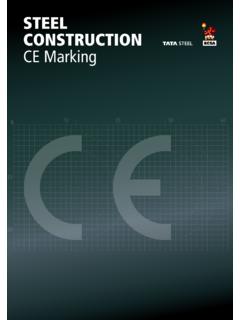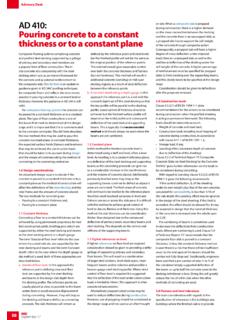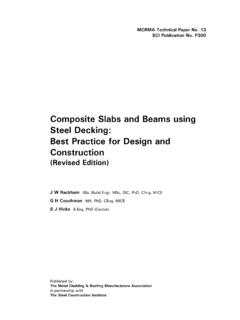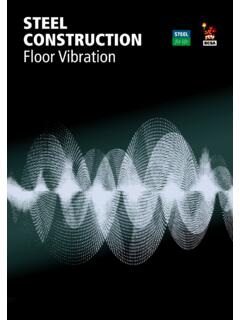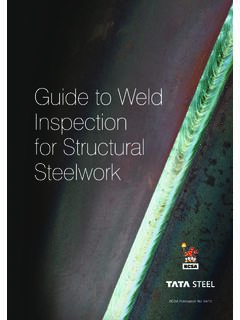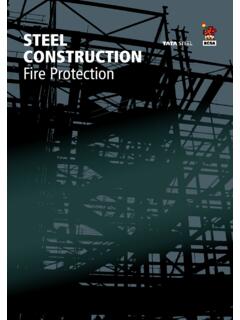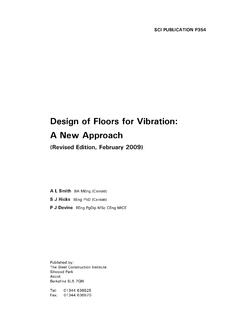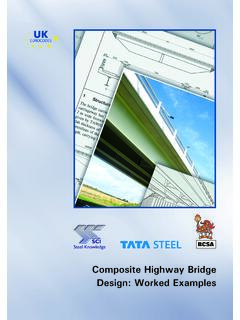Transcription of Design of Composite Beams with Large weB openings
1 Design of Composite Beams with Large weB openingsSponsored by: Design of Composite Beams with Large weB openingsiR M Lawson BSc (Eng) PhD CEng MICE MIStructE MASCE ACGIS J Hicks BEng PhD (Cantab.) Design of Composite Beams with Large weB openingsIn accordance with Eurocodes and the UK National AnnexesSCI PUBLICATION P355ii 2011 SCI. All rights Number: SCI P355 ISBN 978-1-85942-197-0 Published by:SCI, Silwood Park, Ascot, Berkshire. SL5 7QN UKT: +44 (0)1344 636525 F: +44 (0)1344 636570E: report any errors, contact: (The Steel Construction Institute) is the leading, independent provider of technical expertise and disseminator of best practice to the steel construction sector.
2 We work in partnership with clients, members and industry peers to help build businesses and provide competitive advantage through the commercial application of our knowledge. We are committed to offering and promoting sustainable and environmentally responsible service spans the following five areas:Technical information Courses Publications Online reference tools Education Codes and standardsCommunications technology Websites Communities Design toolsConstruction solutions Sustainability Product development Research Engineering solutionsAssessment SCI assessedMembership Individual and corporate membershipApart from any fair dealing for the purposes of research or private study or criticism or review, as permitted under the Copyright Designs and Patents Act, 1988, this publication may not be reproduced, stored or transmitted.
3 In any form or by any means, without the prior permission in writing of the publishers, or in the case of reprographic reproduction only in accordance with the terms of the licences issued by the UK Copyright Licensing Agency, or in accordance with the terms of licences issued by the appropriate Reproduction Rights Organisation outside the concerning reproduction outside the terms stated here should be sent to the publishers, care has been taken to ensure, to the best of our knowledge, that all data and information contained herein are accurate to the extent that they relate to either matters of fact or accepted practice or matters of opinion at the time of publication, SCI, the authors and the reviewers assume no responsibility for any errors in or misinterpretations of such data and/or information or any loss or damage arising from or related to their supplied to the members of the Institute at a discount are not for resale by Library Cataloguing-in- Publication Data.
4 A catalogue record for this book is available from the British text paper in this publication is totally chlorine free. The paper manufacturer and the printers have been independently certified in accordance with the rules of the Forest Stewardship use of Composite Beams with Large rectangular or circular openings is a practical solution when it is required to pass service ducts through the structural zone of the Beams . However, the presence of Large openings in the web raises additional Design considerations. Design guidance was given in an earlier SCI publication, Design for openings in webs of Composite Beams (P068) and Design issues were further explored within a European Coal and Steel Community project, Large web openings for service integration in Composite floors (ECSC project reference 7210-PR-315) and a Research Fund for Coal and Steel valorisation project (RFCS Project RFS-C2-05037).
5 The present publication has been written by Prof. R M Lawson of the SCI and Professor of Construction Systems at the University of Surrey, and Dr S J Hicks of HERA, new zealand (formerly of SCI), with additional contributions from Dr W I Simms and Dr S Bake of SCI. It presents a generalised Design method in accordance with the Eurocodes that may be applied to Beams with discrete and closely-spaced publication supersedes the Design guidance given in publication research and the preparation of this publication were part-funded by Tata Foreword iii Contents v summary viinotation ix introduCtion Background Previous Design guidance Scope of this publication Design standards Material strengths Shear connection Effective slab width Partial shear
6 Connection Transverse reinforcement 17 Design PrinCiPLes For weB openings General Design of unperforated Composite Beams Design of Beams with Large openings Design model Assumptions in the Design model General guidance on positioning of openings Design of non- Composite Beams with Large openings 24 Design resistanCe oF Beams witH unstiFFened openings Design effects at openings Bending resistance at the opening Shear resistance Bending resistance of Tee-sections Web-posts between openings Shear buckling adjacent to an isolated circular opening 55 LimitinG sHear resistanCe For Beams witH CLoseLy sPaCed openings Resistance governed by web-post bending Resistance governed by web-post buckling Verification of shear resistance Eccentricity effects for elongated openings 60 Design resistanCe oF Beams witH stiFFened openings Geometric limitations Beams with horizontal stiffeners Vertical stiffeners Ring stiffeners 68 BeHaViour at serViCeaBiLity Limit state
7 Calculation of additional deflections Approximate method 73 sPeCiaL Cases Highly asymmetric openings End-posts Notched Beams 78 reFerenCes 81 Credits 83 aPPendiX a 85viviisummaryThis publication provides guidance on determining the Design resistance of Composite Beams with Large web openings . The Composite Beams comprise steel I sections with either regular or isolated openings and with a concrete slab on the top flange, connected to the steel section by shear studs. The scope covers rolled steel sections with openings cut in the web, fabricated sections manufactured from rolled sections cut to a profile along the web and re-welded to form a regular pattern of web openings , and plate girders fabricated from three steel plates where the holes are cut in the web plate before welding the beam.
8 The behaviour of Beams with Large web openings is described and a Design model is presented. Expressions are given for the Design resistances of the various elements of the beam the Tee sections above and below openings , the web posts between openings and the shear connection on the top of the beam, all generally following the principles and terminology of Eurocodes 3 and 4. It is noted that the resistances of non- Composite sections can be determined using the same expressions if the terms for the contribution of the concrete are worked example for a secondary beam with pairs of rectangular and circular openings is presented, illustrating the use of the notation follows that of the Eurocodes, where area of bottom Teecross-sectional area of top Teecross-sectional area of concretecross-sectional area of flange cross-sectional area of horizontal stiffener(s)
9 Cross-sectional area of tensile reinforcementshear area of beamshear area of bottom Teeshear area of top Teecross-sectional area of web of the bottom Teecross-sectional area of web of a Teebeam spacingeffective slab width at any position along the spaneffective slab width at an openingflange widthaverage width of decking rib (minimum width for re-entrant decking); distance between centres of outstand shear connectors in a groupoutstand width of stiffenereffective width of slab for vertical shear resistancediameter of shank of a stud shear connector.
10 Effective depth of concrete resisting vertical sheareccentricity of centre of opening above the centreline of the weboffset distance of centre of stiffener from horizontal edge of openingmodulus of elasticity of steelnotationsecant modulus of elasticity of concretedesign value of concrete compressive strength characteristic compressive cylinder strength of concretecharacteristic compressive cube strength of concreteultimate tensile strength of steelyield strength of steelyield strength of steel in stiffenersdesign axial force in a stiffener (for verifying end anchorage) Design axial resistance of a stiffenertensile force acting on shear connector at the
